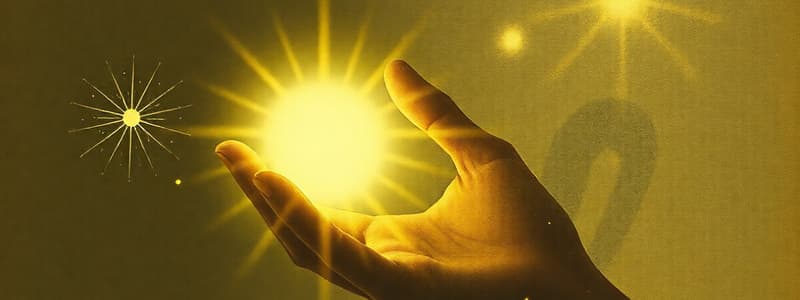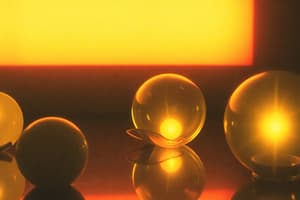Podcast
Questions and Answers
Which of the following best describes the speed of light in a vacuum?
Which of the following best describes the speed of light in a vacuum?
Which of the following is an example of a luminous body?
Which of the following is an example of a luminous body?
What process allows some living organisms to emit light?
What process allows some living organisms to emit light?
Which of the following statements is true regarding non-luminous objects?
Which of the following statements is true regarding non-luminous objects?
Signup and view all the answers
Why do the Moon and planets appear luminous in the night sky?
Why do the Moon and planets appear luminous in the night sky?
Signup and view all the answers
Which of the following is an example of a homogeneous medium?
Which of the following is an example of a homogeneous medium?
Signup and view all the answers
What happens when an iron wire is heated to between 600°C and 800°C?
What happens when an iron wire is heated to between 600°C and 800°C?
Signup and view all the answers
Which of the following is an example of light travelling through a vacuum?
Which of the following is an example of light travelling through a vacuum?
Signup and view all the answers
Signup and view all the answers
Flashcards
Speed of Light
Speed of Light
Light travels at 3 x 10^8 m/s in air and vacuum.
Sources of Light
Sources of Light
Entities that emit light include the Sun, stars, and electric bulbs.
Bioluminescence
Bioluminescence
The process in which living organisms, like fireflies, produce light.
Luminous Bodies
Luminous Bodies
Signup and view all the flashcards
Non-Luminous Bodies
Non-Luminous Bodies
Signup and view all the flashcards
Reflection of Light
Reflection of Light
Signup and view all the flashcards
Optical Medium
Optical Medium
Signup and view all the flashcards
Homogeneous vs Heterogeneous Medium
Homogeneous vs Heterogeneous Medium
Signup and view all the flashcards
Study Notes
Speed of Light
- Light travels very fast, approximately 3 x 10⁸ m/s in a vacuum or air.
- This is equivalent to 300,000,000 m/s or 300,000 km/s.
Sources of Light
- The Sun is the primary light source for Earth, emitting tremendous amounts of heat and light energy.
- Stars are also distant light sources, but appear weaker due to their distance from our solar system.
- Other sources include: glowing electric bulbs, candles, torches, fluorescent tubes, kerosene lamps, and petromax lamps.
- Some insects (e.g., fireflies, glowworms) and some fish produce light through bioluminescence.
Luminous Bodies
- Luminous bodies emit light energy on their own.
- Examples: the Sun, stars, light bulbs, etc.
Non-Luminous Bodies
- Non-luminous bodies do not produce light; they become visible when light falls on them.
- Examples: metals, stones, trees, houses, furniture.
- The Moon and planets are non-luminous; they reflect sunlight.
Key Ideas
- Light can travel through a vacuum.
- Light reaches Earth after traveling through a vacuum from the sun.
General Definitions for Light
- An optical medium is anything (material or non-material) that allows light to pass through partially or wholly.
- A homogeneous medium has a uniform composition throughout.
- Examples of homogeneous media: glass, diamonds, distilled water, clear plastic, vacuum, pure alcohol.
- A heterogeneous medium has a varying composition.
Studying That Suits You
Use AI to generate personalized quizzes and flashcards to suit your learning preferences.
Description
Explore the fascinating properties of light in this quiz, covering its speed, sources, and classification of luminous and non-luminous bodies. Learn how light behaves in different environments and its significance in our daily lives.




